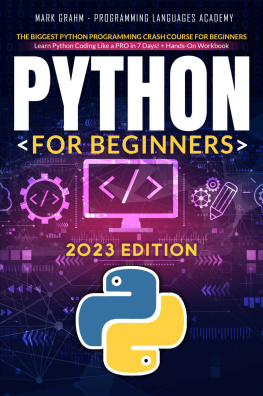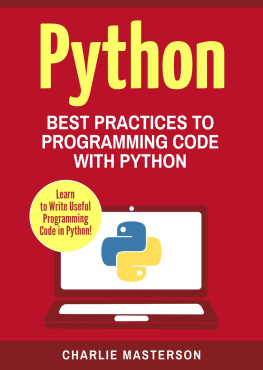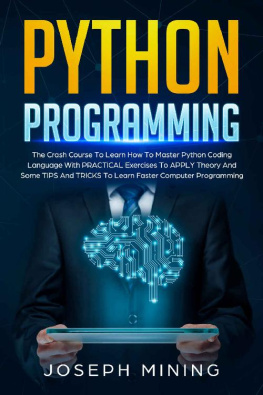LEARN CODING
2 Books in 1:
A Practical Guide to Learn Python and SQL. Discover the Secrets of Programming and Avoid Common Mistakes. Exercises Included
Jason Crash
Easy Navigator
Copyright 2020 Jason Crash - All rights reserved.
The content contained within this book may not be reproduced, duplicated or transmitted without direct written permission from the author or the publisher.
Under no circumstances will any blame or legal responsibility be held against the publisher, or author, for any damages, reparation, or monetary loss due to the information contained within this book. Either directly or indirectly.
Legal Notice:
This book is copyright protected. This book is only for personal use. You cannot amend, distribute, sell, use, quote or paraphrase any part, or the content within this book, without the consent of the author or publisher.
Disclaimer Notice:
Please note the information contained within this document is for educational and entertainment purposes only. All effort has been executed to present accurate, up to date, and reliable, complete information. No warranties of any kind are declared or implied. Readers acknowledge that the author is not engaging in the rendering of legal, financial, medical or professional advice. The content within this book has been derived from various sources. Please consult a licensed professional before attempting any techniques outlined in this book.
By reading this document, the reader agrees that under no circumstances is the author responsible for any losses, direct or indirect, which are incurred as a result of the use of information contained within this document, including, but not limited to, errors, omissions, or inaccuracies.
Learn Python Programming
A Practical Introduction Guide for Python Programming. Learn Coding Faster with Hands-On Project. Crash Course
Table of Contents
Introduction
Congratulations on purchasing Learn Python Programming , and thank you for doing so!
The following chapters will discuss Python programming in detail, with a well-versed example that will help you get a better understanding of different programming concepts with the help of Python. Youve taken the first step to learning a programming language that is famous for its robustness and simplicity.
Taking Python as an example, this book not only introduces the basic concepts of programming but also focuses on the programming language paradigm (process-oriented, object-oriented, function-oriented), as well as the programming language paradigm in Python. This way, the reader not only learns Python but also will have an easier time learning about other programming languages in the future.
The appearance of computer hardware performance has developed by leaps and bounds. At the same time, programming languages have also undergone several changes, resulting in a variety of programming paradigms. Python, with its simplicity and flexibility, has made its way to software industries in spite of many programming languages. Throughout history, we have experienced not only the features of Python but also the main points that the language is meant to address.
Computing has a long history dating back to thousands of years ago. People can calculate and rememberbut whats even more remarkable is their ability to borrow tools. Humans have long used methods and tools to aid in highly complex cognitive tasks such as computation and memory. By tying knots in ropes to record cattle and sheep in captivity, our ancestors had long been able to use the abacus at dizzying speeds. With the development of modern industrialization, the social demand for computation is more and more intense. Taxes need to be calculated, machines need to be built, and canals need to be dug. New computing tools are emerging. Using the principle of a logarithm, people made a slide rule. The slide rule can be moved in parallel to calculate multiplication and division. Charles Babbage, a 19th Century Englishman, designed a machine that used a combination of gears to make highly accurate calculations, hinting at the arrival of machine computing. At the beginning of the 20th century, there were electromechanical computing machines. The electric motor drives the shift gears to squeak until the calculation is made.
During World War II, the war stimulated the need for computing in society. Weapon design requires calculations, such as the design of a tank or the outer hull of a submarine trajectory. The militarization of society requires calculations, such as train scheduling, resource allocation, and population mobilization. As for the missiles and high-tech projects like nuclear bombs, they need massive amounts of computing. Computing itself could even become a weapon. Its worth noting that it was Alan Turing who came up with the idea of a universal computer theoretical concept for the future development of the computer to make a theoretical preparation. The top prize in computer science is now named after Turing in honor of his great service. The Z3 computer, invented by the German engineer Konrad Zuse, can write programs. This invention made the world all set for the evolution of the modern computer.
The most commonly thought of computers are desktops and laptops. In fact, the computer also exists in smartphones, cars, home appliances, and other devices. However, no matter how variable the shape, these computers all follow the von Neumann structure. But in the details, there are big differences between computers. Some computers use a multi-level cache, some have only a keyboard without a mouse, and some have tape storage. The hardware of a computer is a very complicated subject. Fortunately, most computer users dont have to deal directly with the hardware. This is due to the operating system (OS).
An operating system is a set of software that runs on a computer and manages its hardware and software resources. Both Microsofts Windows and Apples IOS are operating systems. When we program, most of the time its through the operating system, which is the middleman to deal with the hardware. The operating system provides a set of system calls, which is what the operating system supports. When a system call is called, the computer performs the corresponding operationalike with pressing a key on a piano, and the piano produces a corresponding rhythm. The operating system, therefore, defines a number of library functions to group system calls to compose a particular function, like a chord made up of several tonesand by programming, we take all these functions and libraries to create beautiful music that is useful.
There are plenty of books on this subject on the marketthanks again for choosing this one! Every effort was made to ensure it is full of as much useful information as possible. Please enjoy!
Chapter 1: Python
This chapter gives a brief introduction to why programming is needed, along with a short introduction about Python.
Why Should You Learn Computer Programming?

Learning any programming language, including Python, opens the door to the computer world. By programming, you can do almost everything a computer can dogiving you plenty of room to be creative. If you think of a needsay, to count the word frequency in a Harry Potter novelyou can program it yourself. If you have a good idea, such as a website for mutual learning, you can open up your computer and start writing. Once you learn to program, youll find that software is mostly about brains and time, and everything else is extremely cheap. There are many rewards to be gained for writing programs. It could be an economic return, such as a high salary or starting a publicly traded internet company. It can also be a reputational reward, such as making programming software that many people love or overcoming problems that plague the programming community. As hackers and painters put it, programmers are as much creators as painters. Endless opportunities for creativity are one of the great attractions of programming.





